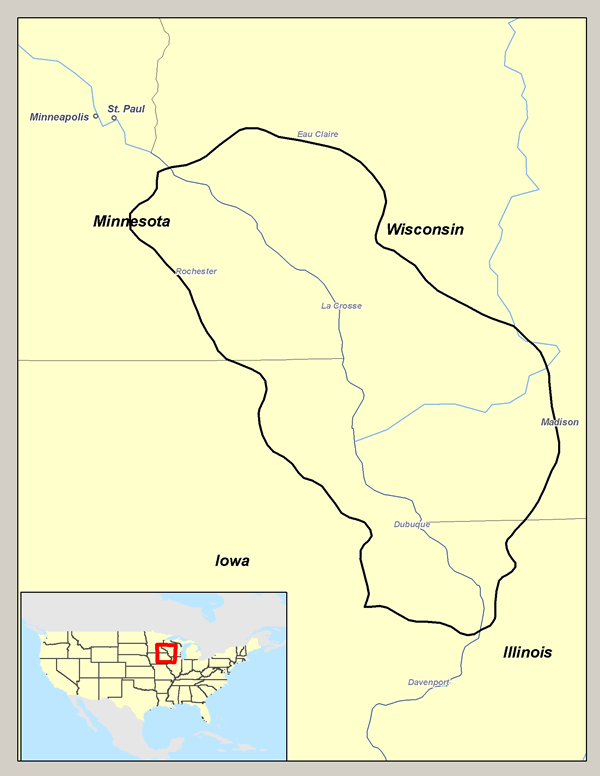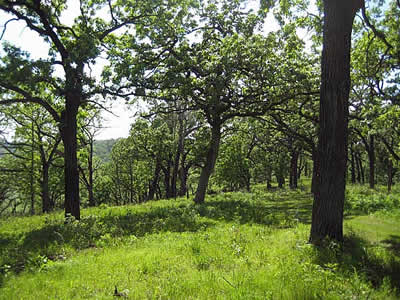Upper Midwest Environmental Sciences Center
Using Habitat to Predict Grassland Bird Abundances Across a Changing Landscape in Southwestern Wisconsin
Loss of grasslands linked with fewer grassland birds
The landscape of southwestern Wisconsin is dominated by a unique ecoregion called the Driftless Area – an expanse of land that was sidestepped by the last glacial movement. Over the last few centuries, humans have heavily altered this region. The fertile uplands – once woven with tallgrass prairie, oak savannah, southern oak and lowland hardwood forests – were harnessed to grow food, raise livestock and build cities. Today, this fragmented mosaic of grasslands, pastures, row crops and converted agricultural fields no longer supports the same biodiversity that it once did and has experienced the decline of native fauna – including several obligate grassland bird species. Experts blame dwindling populations of grassland birds in southwestern Wisconsin – and across America – on the loss and degradation of grassland habitat. However, local scientists believe that it’s possible to restore abundances by implementing conservation management plans that address key habitat variables at the proper scale. |
|
|
To better understand how landscape structure at small and large scales impact grassland bird abundance, researchers from the United States Geological Survey and the University of Wisconsin-Madison designed an investigation framed around the following key questions:
The study was carried out in the following five counties in southwestern Wisconsin: Dane, Grant, Greene, Iowa and Lafayette. Nine species of obligate grassland birds of management concern were surveyed: bobolink (Dolichonyx oryzivorus), dickcissel (Spiza americana), eastern meadowlark (Sturnella magna), grasshopper sparrow (Ammodramus savannarum), Henslow’s sparrow (Ammodramus henslowii), sedge wren (Cistothorus platensis), upland sandpiper (Bartramia longicauda), vesper sparrow (Pooecetes gramineus) and western meadowlark (Sturnella neglecta). |
||
Evaluating general land cover vs. specific landscape characteristics as predictors of bird abundance
 Large scale: General land cover: To determine if the proportion of general land cover can accurately predict grassland bird abundance within a large scale of land, six different landscape types were classified based on relative proportions of land covered in grass and forest:
Large scale: General land cover: To determine if the proportion of general land cover can accurately predict grassland bird abundance within a large scale of land, six different landscape types were classified based on relative proportions of land covered in grass and forest:
- very high grassland
- high grassland: low forest
- high grassland: medium forest
- high grassland: high forest
- low grassland: low forest
- low grassland: high forest
Researchers surveyed the abundance of each bird species within 144, 800-hectare plots (24 of each of each landscape type).
- Small scale: Specific landscape characteristics: Because general land cover (forest vs. grassland) within 800-hectare cells may be too large of a scale to effectively predict abundances of all grassland birds, the study also evaluated more specific habitat characteristics within a smaller area. The research team narrowed down the general land cover types into more detailed categories including proportion hay (alfalfa hay, grass hay, mixed hay), idle grasslands, pasture, row-crop and forest. Then, habitat composition and grassland bird species abundance were surveyed along a 400-meter transect from three survey points within each of the 144 plots.
Results
At the larger scale, researchers expected that landscapes plots composed of high grassland and low forest would support the highest abundances of grassland bird species. This was true for four of the nine species of grassland birds surveyed in the study. Abundances of dickcissels and eastern meadowlark were linked with high grassland cover while upland sandpipers and western meadowlarks were more abundant in high grassland and high grassland/low forest landscapes (Table 1).
At the smaller scale, hay and/or idle grass were the most important habitat features and correlated with higher abundances in six of the nine species of grassland birds included in the study (Table 1).
Table 1. Significant relationships between landscape variables and grassland bird abundance at small and large scales (“—“ indicates no correlation between habitat variable and abundance).
|
Large Scale: General land cover |
Small Scale: Specific landscape characteristics |
dickcissel |
high grassland |
hay, idle grass |
eastern meadowlark |
high grassland |
hay, idle grass, pasture, strip crop |
western meadowlark |
high grassland:low forest |
hay, row crop, strip crop, pasture |
bobolink |
— |
hay, idle grass, pasture, strip crop, row crop |
grasshopper sparrow |
— |
hay, idle grass, pasture, row crop |
sedge wren |
— |
idle grass |
Henslow’s sparrow |
— |
— |
upland sandpiper |
— |
— |
vesper sparrow |
— |
— |
Management implications
Results suggest that 800-hectare landscapes with high amounts of grassland and low amounts of forest support relatively high numbers of some grassland species in southwestern Wisconsin. However, four of the five rarest species were not strongly correlated with general land cover, suggesting that management plans at this scale benefit more abundant species. Therefore, strategies to predict abundances of more rare species should employ species-specific habitat preferences at a smaller scale.
This study also reveals that small-scale habitat variables are useful for predicting grassland bird abundances and generally support that grasslands are important for maintaining grassland bird populations. Future research should explore how habitat variables support specific demographic factors (i.e. nest success, winter survival). Additionally, large-scale conservation efforts should address how small-scale habitat variables impact species-specific habitat preferences.
Adapted from:
Murray, L. D., C. A. Ribic, and W. E. Thogmartin. 2008. Relationship of obligate grassland birds to landscape structure in Wisconsin. Journal of Wildlife Management 72: 463–467.
URL: http://umesc.usgs.gov/terrestrial/migratory_birds/habitat_grassland_bird_abundance.htmlPage Contact Information: Contacting the Upper Midwest Environmental Sciences Center
Page Last Modified: February 1, 2016




